For guitar players eager to deepen their musicality and songwriting, building a robust chord vocabulary is paramount. The prospect of memorizing countless chords might seem daunting, but fear not! This guide will introduce you to ten indispensable guitar chord patterns that serve as building blocks for a vast array of songs and styles.
The secret to efficient chord learning lies in understanding Chord Patterns Guitar. Instead of rote memorization of individual chords, grasping these fundamental shapes allows you to play dozens of chords simply by shifting these patterns around the fretboard. This approach not only accelerates your learning but also enhances your ability to visualize chord progressions and transitions across the guitar neck. Let’s dive into these essential chord patterns.
Power Chords: The Rock Guitar Foundation
Power chords are the bedrock of rock, punk, and metal music. Their raw energy and simplicity make them incredibly versatile and easy to learn. Comprising only three notes – the root, fifth, and octave – power chords are neither major nor minor, lending themselves to a wide range of musical contexts. The name of the power chord is derived from its root note, the lowest note played. For instance, a power chord rooted on the 5th fret of the low E string is an A power chord, often labeled as A5.
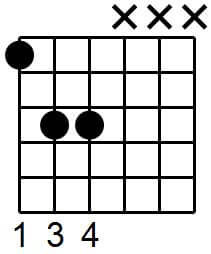 A5 power chord diagram
A5 power chord diagram
This adaptable shape can be anchored on different strings to create various power chords. Here it is rooted on the A string:
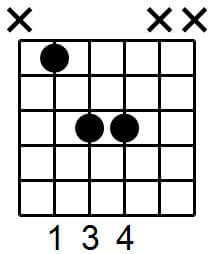 Power chord shape rooted on the A string
Power chord shape rooted on the A string
And finally, the same power chord shape rooted on the D string:
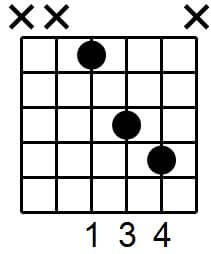 Power chord shape rooted on the D string
Power chord shape rooted on the D string
6-String Major Barre Chords: Unlock Full Chord Voicings
Barre chords, often perceived as challenging for beginners, are a cornerstone technique for any serious guitarist. A barre chord involves using one finger to press down multiple strings across a fret, effectively acting as a movable nut. Mastering barre chords unlocks access to playing any chord in any key across the fretboard.
The 6-string major barre chord pattern is based on the open E major chord shape. If you play an E major chord using your second, third, and fourth fingers, you’ll notice your first finger is free. By shifting this E major shape up the neck and using your first finger to barre across all six strings where the nut would be in the open E position, you create a movable major chord shape. Like power chords, the root note dictates the chord’s name.
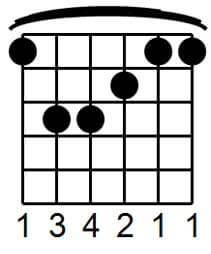 6-string major barre chord diagram based on Emaj shape
6-string major barre chord diagram based on Emaj shape
6-String Minor Barre Chords: Adding Melancholy to Your Sound
The distinction between a 6-string major and minor barre chord lies in a single note: the major third. In the major barre chord shape, the major third is played by your middle finger on the G string. To transform a major barre chord into a minor barre chord, you need to “flatten” this major third, lowering it by a semitone (one fret). In this specific barre chord pattern, the flattened third is already covered by your first finger barre. Therefore, to create a minor barre chord, simply remove your middle finger from the G string. This resulting shape closely resembles an open E minor chord shape.
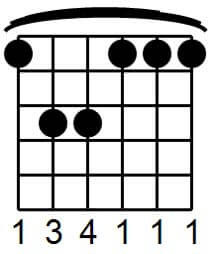 6-string minor barre chord diagram based on Emin shape
6-string minor barre chord diagram based on Emin shape
5-String Major Barre Chords: Rooted on the A String
Major barre chords aren’t limited to the 6-string E shape; they can also be rooted off the A string. This 5-string major barre chord pattern is based on the open A major chord shape. This shape can be more challenging initially, but practicing it expands your barre chord vocabulary and provides alternative voicings.
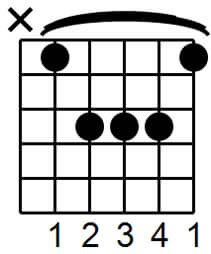 5-string major barre chord diagram based on Amaj shape
5-string major barre chord diagram based on Amaj shape
5-String Minor Barre Chords: A-String Minor Voicings
Just like the 6-string version, you can easily convert the 5-string major barre chord into a minor barre chord by flattening the major third. In this A-string rooted shape, the major third is located on the B string. By adjusting your finger placement (or simply barring correctly), your barre chord takes on a form similar to a standard open A minor chord.
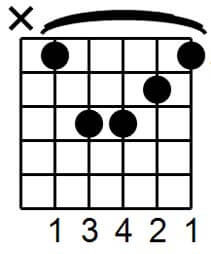 5-string minor barre chord diagram based on Amin shape
5-string minor barre chord diagram based on Amin shape
6-String Dominant 7 Chords: Adding Blues and Flavor
Dominant 7 chords are a fantastic tool to inject bluesy and jazzy nuances into your chord progressions. The 6-string dominant 7 chord shape is derived from the 6-string major barre chord. To create it, simply lift your little finger from the high E string. This removed note is an octave of the root, and its absence allows the crucial b7th note to be prominently featured in the chord, giving it its dominant 7 character.
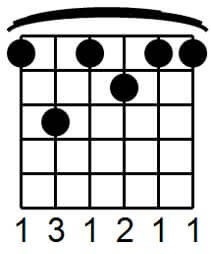 6-string dominant 7 chord diagram
6-string dominant 7 chord diagram
5-String Dominant 7 Chords: A-String 7th Chords
Mirroring the 6-string approach, the 5-string dominant 7 chord is built upon the 5-string major barre chord shape. The conversion is similar: you modify the shape to include the flattened 7th. Typically, this involves adjusting your middle finger to create the b7 interval, transforming the major chord into a dominant 7th.
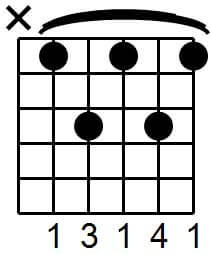 5-string dominant 7 chord diagram
5-string dominant 7 chord diagram
6-String Minor 7 Chords: Smooth and Sophisticated
While dominant 7 chords contain a major third, allowing them to function as major-type chords in some contexts, flattening the major third transforms them into minor 7 chords. The 6-string minor 7 chord shape is derived from the 6-string dominant 7 shape. Simply remove the middle finger, which was previously on the G string, to flatten the third and create the minor 7 sound.
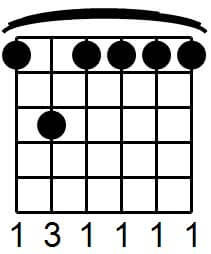 6-string minor 7 chord diagram
6-string minor 7 chord diagram
5-String Minor 7 Chords: A-String Minor 7th Variations
The principle of flattening the major third to create a minor 7th chord also applies to the 5-string barre chord shape. By modifying the 5-string dominant 7 chord shape to flatten the third, you arrive at the 5-string minor 7 chord.
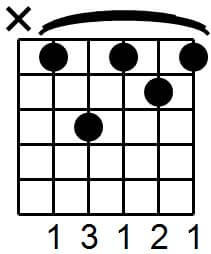 5-string minor 7 chord diagram
5-string minor 7 chord diagram
7#9 Chords (The Hendrix Chord): Unleash Funky Blues Rhythms
The final chord pattern in this essential collection is the 7#9 chord, famously known as the Hendrix chord. This chord is a staple in rock and blues, particularly for funky rhythm guitar parts. While labeled a 7th chord, it’s more accurately described as a re-voiced dominant 7th. It features the root on the A string, the major third on the D string, and the b7 on the G string. Notably, it omits the 5th from the major scale, contributing to its unique voicing. The crucial #9 note is played on the B string, adding its signature dissonant and bluesy flavor.
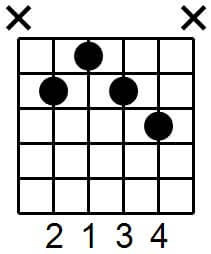 7#9 chord diagram, the Hendrix Chord
7#9 chord diagram, the Hendrix Chord
By mastering these ten fundamental chord patterns guitar, you’ll significantly expand your guitar playing capabilities and unlock a world of musical possibilities. Practice these shapes in different keys and musical contexts to truly internalize them and elevate your guitar skills.
